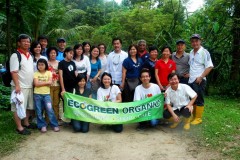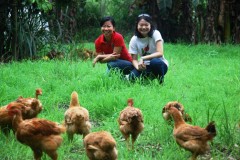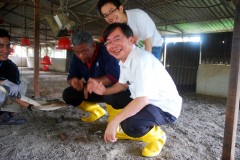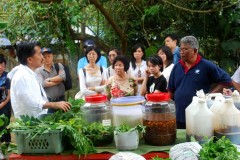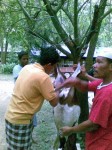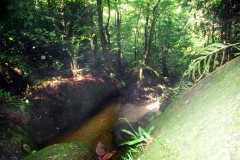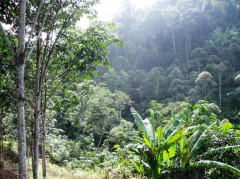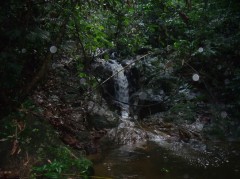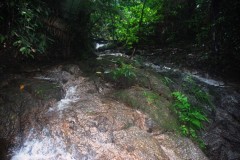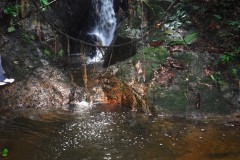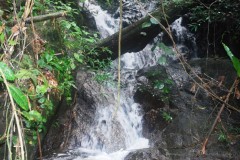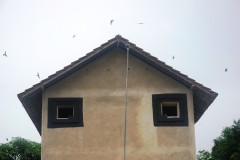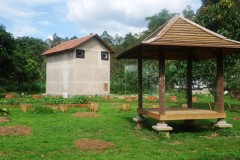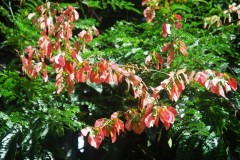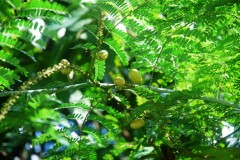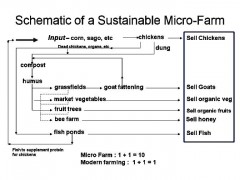Nov 29, 2009
EcoGreen came visiting
The owners of one of the most established organic shops and restaurants, EcoGreen Organic, came visiting with some of their customers. We don't farm in 'secret' and we don't have 'show' farms. And we don't believe organic farming should have anything to do with contract farming. WYSIWYG!
Here's a group photo.
The owner and head chef of EcoGreen, Sherene with her daughter Li Hua, up close with our free-range, grassfed chickens.
Brig Gen (R) Dato' Adnan, who owns a training camp near DQ Farm and Mr. Wong the owner and CEO of EcoGreen smelling the 8 year old litter which all visitors must submit themselves to.
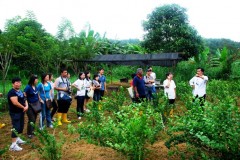
Stuff that we use in the farm to repel insects, to reduce fungal attacks, to boost the immune system of the chickens and to generally make the farm a place that first time visitors feel 'energised'.
15:21 Posted in Visitors | Permalink | Comments (0) | Tags: farm visit, organic farm visit, ecogreen
Nov 28, 2009
Raya Korban At The Farm
A goat was sacrified for Raya Korban yesterday at the farm; in commemoration of Prophet Abraham's willingness to sacrifice his son as an act of submission to the will of God.
Muslims at the farm from Indonesia, Myanmar and Bangladesh participated. Pak Cik Razaly, the farm manager, presided.
The chosen animal was strong, healthy and one of the best in the herd.
It was treated with great respect; gently led rather than pulled or pushed.
Care was taken that it was not stressed, the knife was hidden from its eyes, and it was gently blind-folded and made to face the kiblah.
Recently I saw a program on Astro of an organic farm in the UK where the intention of the owner was to bring urbanites to his farm to experience 'real' life, including the butchering of animals for food as opposed to buying them off the shelf in sanitary packs.
There was a scene where a stunner was used on the cockerel that they were intending to butcher. I could clearly see the suffering and pain the cockerel went through as it was being stunned.
It must be painful and traumatic to be stunned to unconsciousness!
Here, in the farm, I could see very clearly that the animal felt little if any pain at all. In fact a research done by Wilhem Schulze, a professor in veterinary medicine, in 1978 indicates that ritual slaughtering of animals may be more humane than modern methods.
I am impressed with the respect that was accorded the animal yesterday, and for this fact alone, in my opinion, we should not participate in modern commercialised meat production as a consumer.
11:22 Posted in Blog | Permalink | Comments (0) | Tags: aidil adha, raya korban, ritual slaughtering
Nov 09, 2009
New Waterfall
We entered into an area of the forest where no human have entered before (or at least, not for a long, long while). The 'feel' is different. There was no sense of 'fear' from the jungle. We felt 'protected', and being 'embraced' and one feels a reluctance to leave. There were no mosquitoes, no disturbances. Only the quiet peace of a 100 million year old rain forest.
The forest that we entered looking for a water source for our farm:
We reached the area after following a series of newly discovered small waterfalls rising over 100 meters. We named the falls 'Air Terjun Wahyu / Wahyu Falls' after Ali Wahyudi our Indonesian Technical Adviser who first discovered the falls.
How long ago was it when the first hominid appeared? 8 million years?
Is it not possible for another intelligence, another 'awareness' to have developed in our rain forests over the 150 million years of its existence ?
I must go back to the peace of the rain forest ....
10:42 Posted in Blog | Permalink | Comments (5) | Tags: waterfalls. rain forest
Nov 05, 2009
Caviar of the East - The Newly Weds Came
On 30th Oct we switched on the sounds on a permanent basis. Today, we noticed the droppings of at least 10 pairs of newly weds. This must surely break all records for the time it takes for the walit to take up home in a man-made structure.
The walit in a farm like DQ provides a useful function in keeping the insect population low. We first noticed the walit when we were scratching our heads as to why our honey bees just keep on disappearing. Then we put two and two together.
Completed walit house plus garden.
15:49 Posted in Blog | Permalink | Comments (3) | Tags: swiftlet farming, walit
Nov 02, 2009
Lovely Mimosa
The forest around the farm never fails to surprise me. After 20 years you would have thought I have seen it all. Then suddenly this lovely mimosa appeared. Recently it was a strange passiflora.
What a lovely mimosa (click on pics to enlarge).
The seeds with a single wing.
The distinctive mimosa leaves.
The fruits.
17:10 Posted in Blog | Permalink | Comments (0) | Tags: mimosa
Sustainable Farming - A Model
To be sustainable, inputs must be less than outputs. Inputs include fuel and all forms of energy, labour and raw materials. Even treatment of wastes must not consume excessive energy. For a farmer to practice sustainable agriculture, he must derive a reasonable income from his efforts.
This is a model for sustainable agriculture we developed at our farm (click to enlarge):
This how an acre of land may look like (click to enlarge):
We calculated a net income of RM3000 to RM5000 per month is possible from such a farm.
10:22 Posted in Sustainable Farming | Permalink | Comments (3) | Tags: sustainable farming, sustainable agriculture








